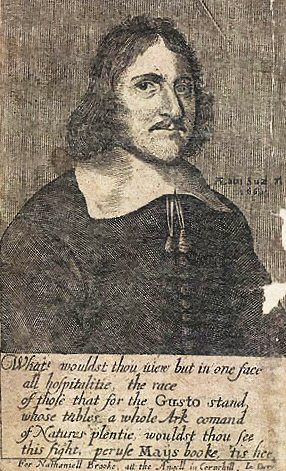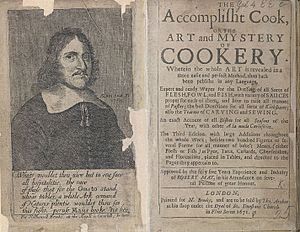Robert May (cook) facts for kids
Quick facts for kids
Robert May
|
|
|---|---|
 |
|
| Born | 1588 Wing, Buckinghamshire, England
|
| Died | in or after 1664 |
| Occupation | Chef |
Robert May (born in 1588, died sometime after 1664) was a famous English chef. He learned to cook in France and then worked in England. He is most well-known for his cookbook, The Accomplisht Cook, which he published in 1660. This book was one of the first big collections of English recipes. It taught people how to make many different kinds of soups, broths, and both sweet and savory pies.
Contents
Robert May's Early Life and Training
Robert May was born in 1588 in a place called Wing, in Buckinghamshire, England. His parents were Edwarde and Joan Mayes. Even though he was born in 1588, he wasn't officially baptized until April 2, 1592.
Family of Cooks
Robert's father, Edwarde Mayes, was also a chef. He worked as the main cook for the Dormer family at their home, Ascott Park. Cooking was clearly a family talent!
Learning to Cook in France
When Robert was just ten years old, Lady Dormer sent him to Paris, France. There, he spent five years training to become a professional chef. After his training in France, he came back to London, England. He continued his learning by working for Arthur Hollinsworth, who was the cook for important places like Grocer's Hall.
Becoming a Head Chef
After finishing his training, Robert May returned to his hometown of Wing. He joined his father at Ascott Park and became one of five cooks working under him. Later, in the mid-1630s, a man named Sir Anthony Browne hired Robert May. He became the head chef at Sir Anthony's country home, Cowdray House, in west Sussex.
Working for Noble Families
Robert May worked for many important families in England. He was a chef for thirteen different noble households. Many of these families were Catholic. He continued working for them until the English Civil War began in 1642. This war lasted until 1651.
The Accomplisht Cook Cookbook
After the English Civil War ended, Robert May decided to write a cookbook. He published it in 1660 and called it The Accomplisht Cook. Its full title was Or the Art and Mystery of Cooking.
Editions of the Book
The first version of The Accomplisht Cook came out in 1660. Robert May continued to update his book, and the last version he worked on was published in 1665. The 1685 edition of the book was quite large, with about 300 pages. This shows how popular and important his recipes were!
What's Inside the Cookbook?
Robert May's cookbook included old cooking traditions from the Middle Ages. But he also added new and popular food ideas from Europe. For example, he included recipes for French bisque (a creamy soup) and Italian brodo (broth).
The Accomplisht Cook is still known today for its amazing collection of soups and broths. About 20 percent of the book is dedicated to these recipes! The book also contains some of Robert May's own memories and stories from his life as a chef.
A Rare Find
In 2007, a very old edition of the book from 1678 was found and put up for sale. An auctioneer named Charles Hanson said that probably no more than 200 copies of these books were ever printed back then. This makes the book a very special and rare piece of history!


